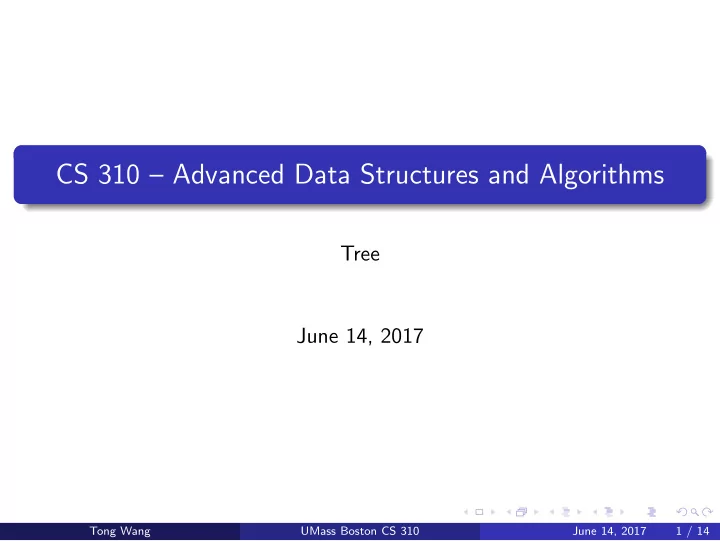

CS 310 – Advanced Data Structures and Algorithms Tree June 14, 2017 Tong Wang UMass Boston CS 310 June 14, 2017 1 / 14
Tree Tree is a fundamental data structure in computer science Almost all operating systems store files in trees or treelike structures. A tree consists of a set of nodes and a set of directed edges that connect pairs of nodes. One node is distinguished as the root Every node c, except the root, is connected by an edge from exactly one other node p. Node p is c’s parent , and c is one of p’s children A unique path traverses from the root to each node. Node that has no children is called a leaf Tong Wang UMass Boston CS 310 June 14, 2017 2 / 14
Tree A tree with N nodes must have N - 1 edges because every node except the parent has an incoming edge. The depth of a node in a tree is the length of the path from the root to the node. The depth of the root is always 0 The depth of any node is 1 more than the depth of its parent The height of a node in a tree is the length of the path from the node to the deepest leaf. The height of a tree is the height of the root Nodes with the same parent are called siblings If there is a path from node u to node v, then u is an ancestor of v and v is a descendant of u. If u � = v, then u is a proper ancestor of v and v is a proper descendant of u. Tong Wang UMass Boston CS 310 June 14, 2017 3 / 14
Textbook figure 18.1 Tong Wang UMass Boston CS 310 June 14, 2017 4 / 14
A tree viewed recursively Textbook figure 18.2 Tong Wang UMass Boston CS 310 June 14, 2017 5 / 14
Hierarchical File System Textbook figure 18.4 Tong Wang UMass Boston CS 310 June 14, 2017 6 / 14
Data Structure class Node { String name; Node parent; Node List<Node> children; public Node(String name, Node parent) { this.name = name; this.parent = parent; this.children = new ArrayList<Node>(); } } Tong Wang UMass Boston CS 310 June 14, 2017 7 / 14
Print all file names using Breadth First Search (BFS) public void bfs(Node root){ if(root == null) return; List<Node> queue = new ArrayList<>(); queue.add(root); while(!queue.isEmpty()){ Node node = queue.remove(0); System.out.print(node.name + " "); for(Node n:node.children){ queue.add(n); } } } Tong Wang UMass Boston CS 310 June 14, 2017 8 / 14
Binary Trees A binary tree is a tree in which no node can have more than two children. Because there are only two children, we can name them left and right . public class TreeNode { int val; TreeNode left; TreeNode right; TreeNode(int x) { val = x; } Tong Wang UMass Boston CS 310 June 14, 2017 9 / 14
Tree Traversals Preorder (Root, Left, Right): 100, 19, 17, 2, 7, 3, 36, 25, 1 Inorder (Left, Root, Right): 2, 17, 7, 19, 3, 100, 25, 36, 1 Postorder (Left, Right, Root): 2, 7, 17, 3, 19, 25, 1, 36, 100 Tong Wang UMass Boston CS 310 June 14, 2017 10 / 14
Preorder From Wikipedia Tong Wang UMass Boston CS 310 June 14, 2017 11 / 14
From Wikipedia Tong Wang UMass Boston CS 310 June 14, 2017 12 / 14
From Wikipedia Tong Wang UMass Boston CS 310 June 14, 2017 13 / 14
Recommend
More recommend